The Greeks of Vienna
After the second Turkish siege of Vienna (1683) and the following peace treaties of Karlowitz (1699) and Passarowitz (1718) - along with their related trade agreements -, Vienna became an important commercial center for the merchants of the Ottoman Empire. The first church may have been the private chapel in the house of the Ottoman Ambassador Alexandros Mavrokordatos ''ex Aporriton''. St. George's brotherhood was founded in 1723/26 by Greek-Orthodox merchants of the Ottoman Empire. In 1802, George Karayiannis bought the house, which nowadays houses the Church of St. George. In 1776, Maria Theresia granted the brotherhood of St. George privileges, which were confirmed by Joseph II in 1782 and his successors after him.
In 1766, 134 Ottoman citizens were engaged in commerce in Vienna. 82 of them were Greeks. During 18th and 19th c., the Viennese Greeks were coming mainly from the areas of Epirus, Macedonia and Thessaly.
A few steps down the alley of ''Griechengasse'' lead to the church of Holy Trinity. The community of Hole Trinity received imperial privileges in 1787. It was founded by members of the Greek-Orthodox community, who acquired Habsburg Empire's citizenship. A total renovation/restoration of the building took place during the period 1857-1859 based on the blueprints by Theophil Hansen and funded by Simon Sinas. St. George was also renovated/restored in 1898.
A foundation of a Greek school was enacted by the Greek-Orthodox community of Holy Trinity in 1801 and on the 6th of May 1804 the Emperor Franz I granted to the Greek national school the ''public status'' (Öffentlichkeitsrecht). Nowadays, the school is still located at the old premises of the former National school, on the first floor above the Church of Holy Trinity. Metropolis of Austria is located at the same place since 1963.
Many Greeks belonged to the upper-classes of Viennese society and some of them managed to be considered as aristocrats (knights, barons and counts). Members of the families Sina, Karajan, Dumba, Duka, Curti, Tirka, Spirta and Karpa played a vital role in Vienna of the 19th c.
Baron George Sina from Hodos and Kisdia (1782-1856) was the owner of one of the most important Banks in Vienna and he became deputy director of the Austrian National Bank. He financed partial sections of the Viennese South railway network while he funded the construction of the chain bridge between Buda and Pest during the period 1842-1849. In addition, he provided the land, in which the k.k. Polytechnic institute (today: Technical University of Vienna) was constructed. In 1877, ''Sinangasse'' took its name after him in Leopoldstadt.
Nikolaos Doumbas (1830-1900) was a member of the House of Lords and the founder of the male voice choir's club, the predecessor of the Viennese society of Music. He, also, served as chief director of the first Austrian saving Bank during the period 1880-1900. In his will, Doumbas included the donation of 200 autographs of Schubert to the city of Vienna. He also donated a certain amount of money to the University of Athens as well as to the orphanage of his home town, Serres. The street in front of the Viennese society of music was named after him in 1900.
An important character, who lived and worked in Vienna, was Rigas Velestinlis (1758-1798), whose portrait can be found still at the church of St. George. Rigas came to Vienna in the last decade of the 18th c. and he printed his books. Since they were no printers in the Ottoman Empire, Rigas could spread his revolutionary ideas only from abroad. He published several political works of his - such as the ''Charter'' of Greece -, sings and translated novels. Velestinlis is now considered as national hero in Greece. In addition to Rigas' works, the scientific and literary journal ''Ἑρμὴς ὁ λόγιος'' (''the scholar Hermes'') was also published in Vienna in 1811, by the archimandrite of St. George's church Anthimos Gazis (1758-1828). During the end of the 18th c. and the beginning of the 19th c., most of the Greek schoolbooks and Greek researchers were being printed in Viennese printing houses.
The Beidermeier cemetery in Sankt Marx includes a Greek sector, in which the members of the Greek-Orthodox doctrine of Vienna were buried from 1784 and onwards. Unfortunately, nowadays the inscriptions are hardly readable and their dates have worn out.
Another proof of a very famous Greek family in Vienna is the tombstone of the knight Theodor von Karajan, which is located in St. Marx. The family of Karajan (Karagiannis) moved from Kozani to Vienna during the time of Georg von Karajan (1743-1813), founder and patron of St. George's church. His son, Theodor von Karajan (1810-1873), became professor of German philology at the University of Vienna. Among other positions, he served as President of the Austrian Academy of sciences from 1866 until 1869. He was the great-grandfather of the music conductor Herbert von Karajan. Karajangasse in the 20th district was named after Georg von Karajan in 1889.
The house at Number 18 of the Fleischmarkt street belonged to the Greek merchant Christoph Nako. An inscription on the right and left on embossed depiction of the Emperor Joseph II praises his tolerance patron of 1781, which was giving the permission to the orthodox Greeks to practice their religion freely: ''This house is perishable, but Joseph's fame never; He gave us tolerance, he gave us immortality''.
Also, in the Fleischmarkt'' street at the number 12 is located the Darvarhof, named after Ioannis Davaris who bought the house in 1795. It has been replaced by a new building since 1895.
Even if a number of Greeks, who were settled in Vienna, either moved back to Greece or were integrated into the local society, both communities of St. George and Holy Trinity remain active to this present day.
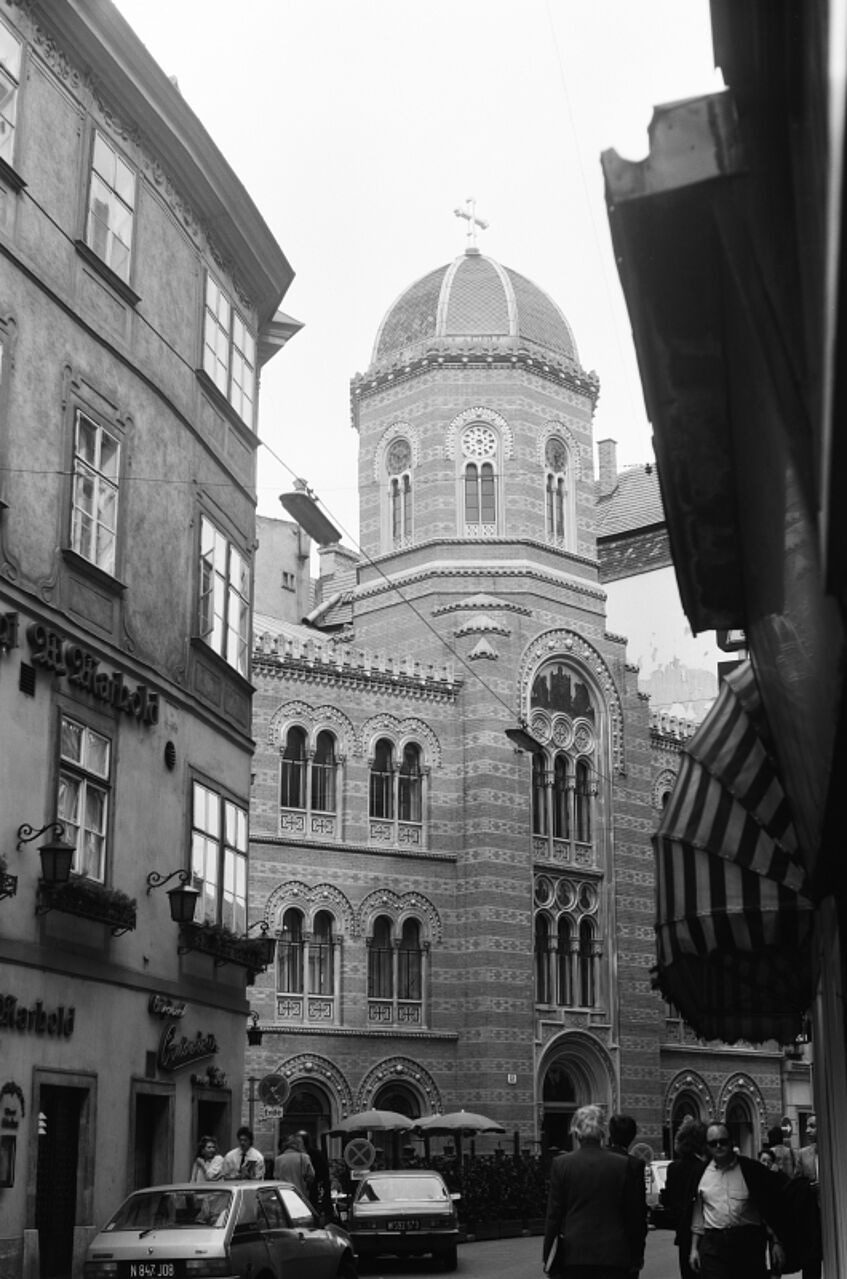
The church of Holy Trinity, Fleischmarkt (1920) Austrian National Library / Vienna, Widter F. 9.198B.
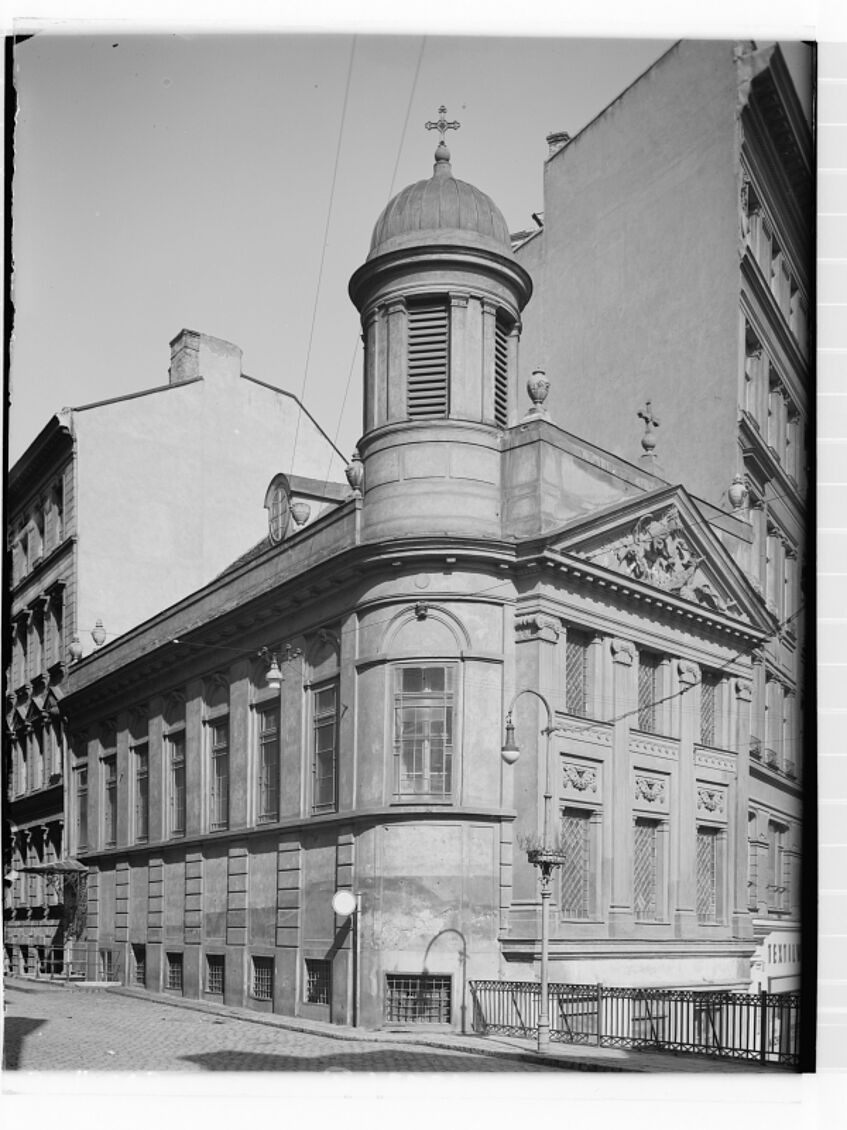
The church of St. George (1957), Austrian National Library/Vienna, Winkler 504.263B.
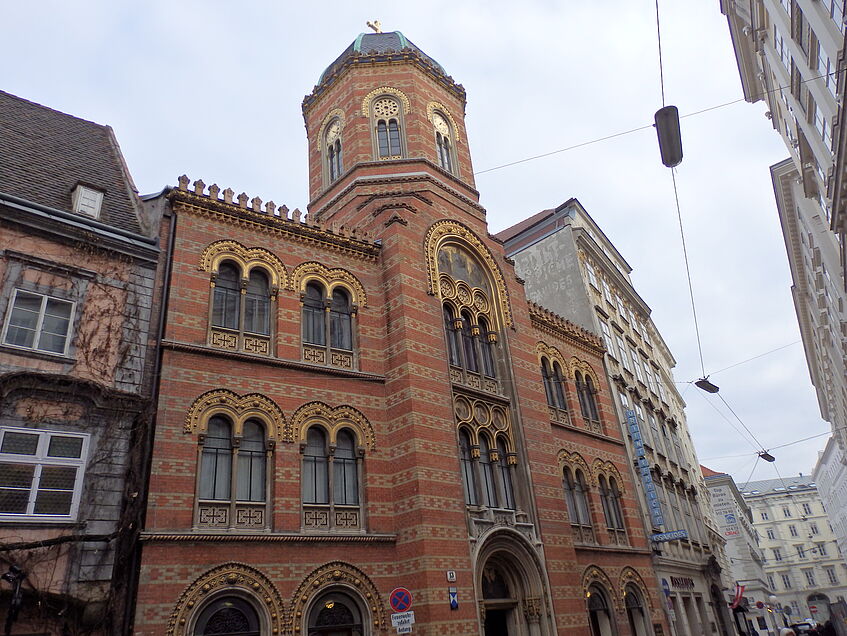
The church of Holy Trinity today (2015).
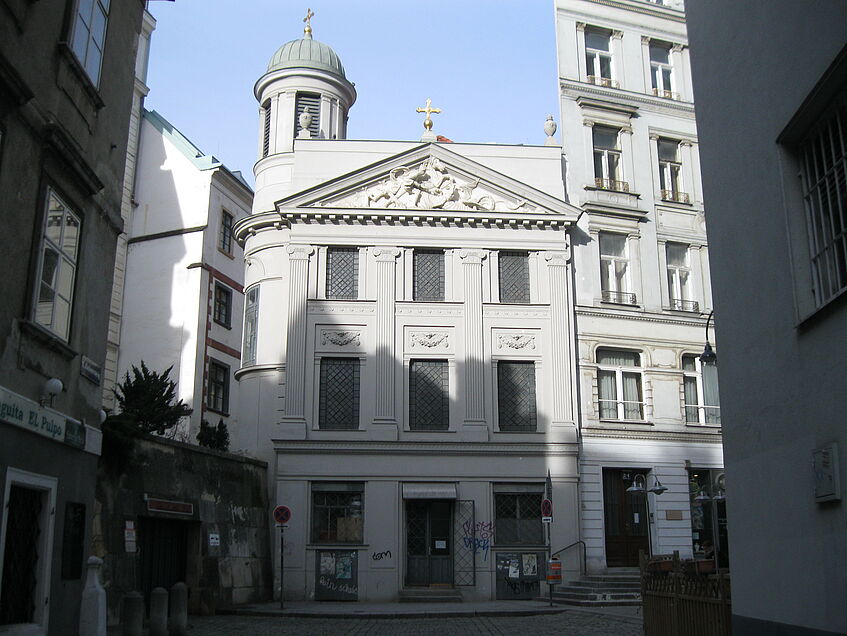
The church of St. George, Hafnersteig (2017)
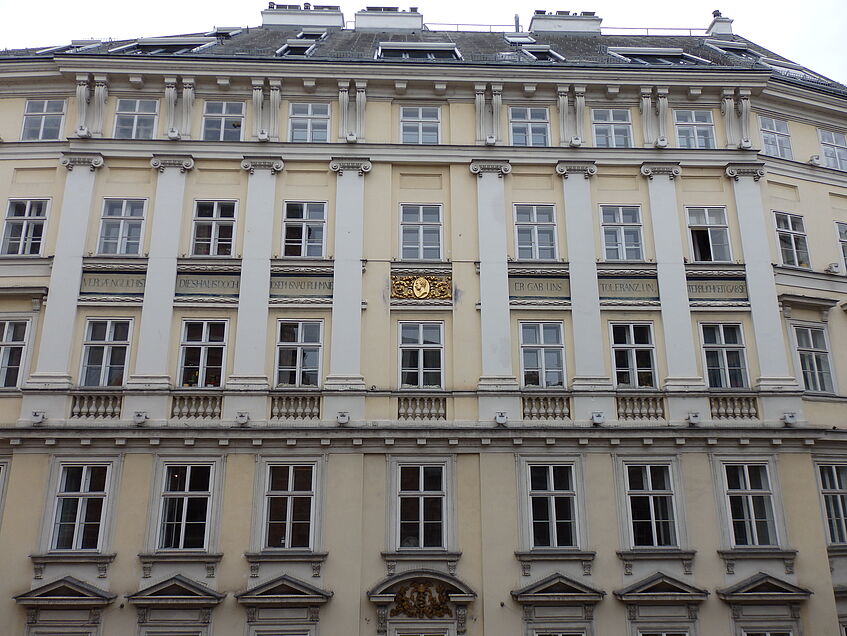
Opposite the Church of Holy Trinity (Fleischmarkt 18) is the Nakos' House / Tolerance House.
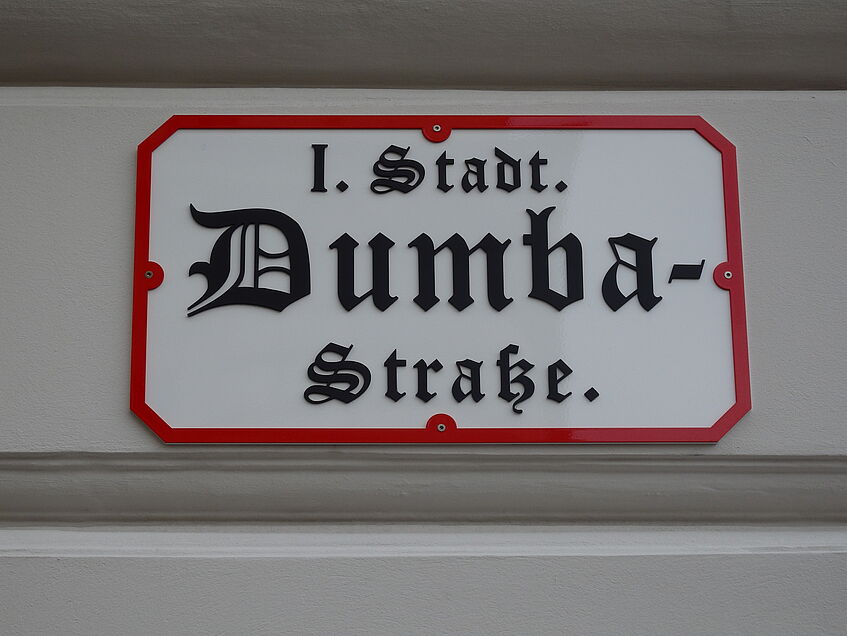
Dumbastraße in front of the Künstlerhaus was named after Nikolaus Dumba in 1900.
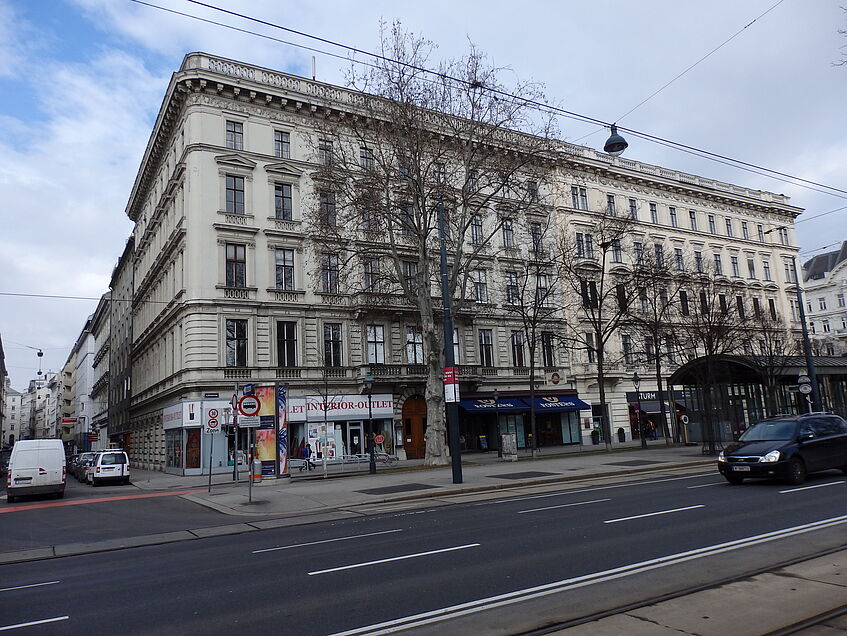
The Palais Dumba at Parkring 4, Zedlitzgasse corner .
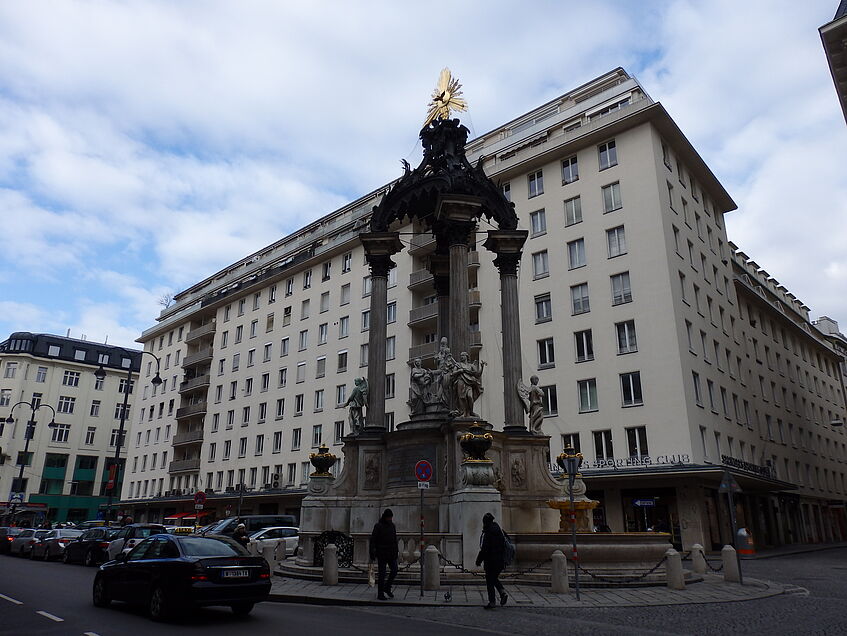
At the Hohen Markt 8 stood the Palais Sina. The facade was rebuilt in 1859 by the architect Theophil Hansen. The building was burnt in 1945.
Bibliography
- Efstratiadis, Sofronios, Ο εν Βιέννη ναός του Αγίου Γεωργίου και η κοινότης των Οθωμανών υπηκόων, Alexandria 1912 [Charalampos G. Chotzakoglou (ed.) with a register compiled by Georgios Laios]. Athens2 1997.
- Katsiardi-Hering, Olga, Greeks in the Habsburg Lands (17th-19th centuries): Expectations, Realities, Nostalgias. In: Kröll, Herbert (ed.), Austrian-Greek encounters over the centuries. Innsbruck 2008, 147-158.
- Katsiardi-Hering, Olga/Stassinopoulou, Maria A., The Long 18th Century of Greek Commerce in the Habsburg Empire. In: Heppner, Harald/Urbanitsch, Peter/Zedinger, Renate (eds.), Social Change in the Habsburg Monarchy [The Eighteenth Century and the Habsburg Monarchs. International Series 3]. Bochum 2011, 191-213.
- Laios, Georgios, Pol. K. Enepekides, Griechische Handelsgesellschaften und Kaufleute in Wien aus dem Jahre 1766 (Rezension). In: Δελτίον της Ιστορικής και Εθνολογικής Εταιρείας της Ελλάδος 14 (1960), 615-617.
- Lanier, Amelie, Die Geschichte des Bank- und Handelshauses Sina. Frankfurt/M. etc. 1998.
- Loukatos, Spyridon, Ο πολιτικός βίος των Ελλήνων της Βιέννης κατά την Τουρκοκρατίαν και τα αυτοκρατορικά προς αυτούς προνόμια [The political life of the Greeks of Vienna during the Ottoman period and the imperial privileges granted to them]. In: Δελτίον της Ιστορικής και Εθνολογικής Εταιρείας της Ελλάδος 15 (1961), 287-356.
- Peyfuss, Max D., Balkanorthodoxe Kaufleute in Wien. Soziale und nationale Differenzierung im Spiegel der Privilegien für die griechisch-orthodoxe Kirche zur Heiligen Dreifaltigkeit. In: Österreichische Osthefte 17 (1975), 258-268.
- Plöchl, Willibald M., Die Wiener Orthodoxen Griechen. Eine Studie zur Rechts- und Kulturgeschichte der Kirchengemeinden zum Hl. Georg und zur Hl. Dreifaltigkeit und zur Errichtung der Metropolis von Austria. Wien 1983.
- Schmidtbauer, Peter, Zur Familienstruktur der Griechen in Wien. In: Wiener Geschichtsblätter 35/3 (1980), 150-160.
- Seirinidou, Vassiliki, “Griechischer Handelsmann”. Anatomizing a collective subject. In: Herbert Kröll (ed.), Austrian-Greek encounters over the centuries. History – diplomacy – politics – arts – economics. Innsbruck 2007, 129-137.
- Seirinidou, Vaso, Έλληνες στη Βιέννη. 18ος–μέσα 19ου αιώνα [Greeks in Vienna. 18th–first half of the 19th century]. Athens 2011.
- Stassinopoulou, Maria A. /Chatziioannou, Maria Christina, Διασπορά–Δίκτυα–Διαφωτισμός [Diaspora–Networks–Enlightenment]. Athens 2005.
- Stassinopoulou, Maria A., Αρχειακές πηγές για την ιστορία της κοινότητας της Αγίας Τριάδας της Βιέννης. Νέες προoπτικές [Archival sources on the history of the Greek-Orthodox Community of the Holy Trinity in Vienna. New perspectives]. In: Εώα και εσπέρια 7 (2007), 401-408.
- Stoianovich, Traian, The Conquering Balkan Orthodox Merchant. In: Journal of Economic History 20/2 (1960), 234-313.
- Tsigaras, Georgios Ch., Ο ναός του Αγίου Γεωργίου Βιέννης. Ιστορία και τέχνη [The church of St. George in Vienna. History and Art]. Thessaloniki 2005.
- Konecny, Elvira, Die Familie Dumba und ihre Bedeutung für Wien und Österreich [Dissertationen der Universität Wien 179]. Wien 1986
